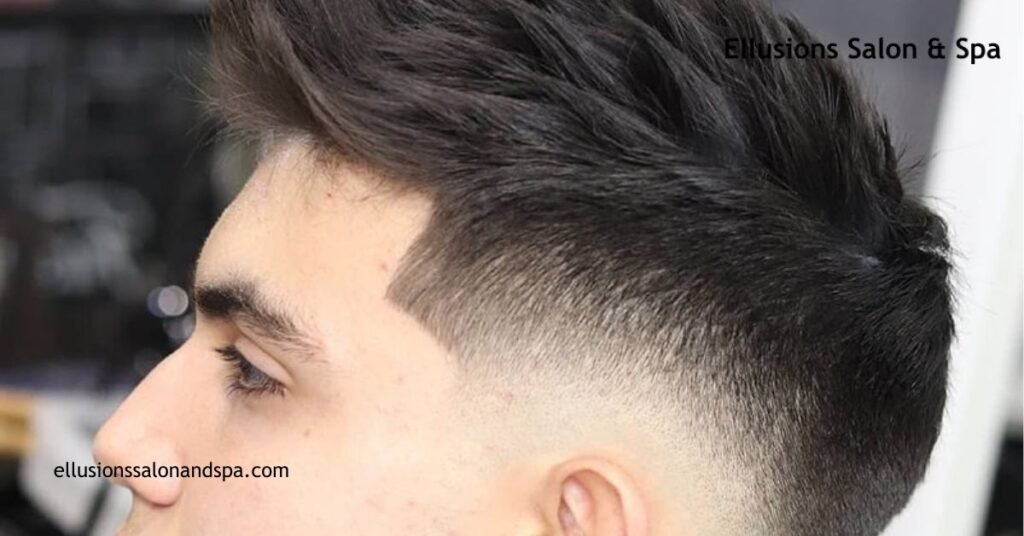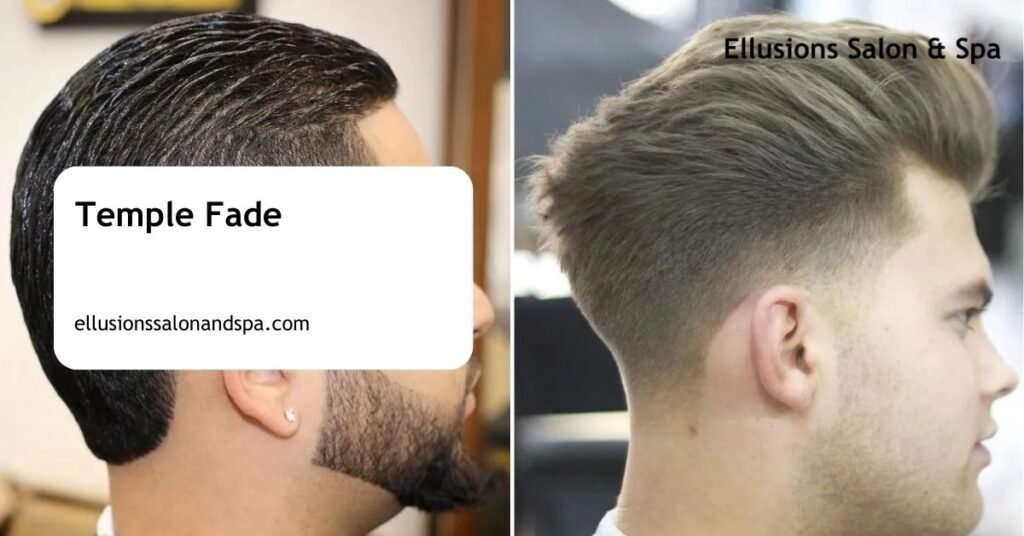If you’re looking to elevate your hairstyle game, the temple fade might just be the perfect choice for you. This trendy cut blends sophistication with a touch of edge, making it a favorite among style-savvy individuals. With its clean lines and gradual transition, the temple fade enhances your facial features while adding a modern twist to your overall look.
Imagine walking into a room and turning heads with a haircut that’s both timeless and contemporary. Whether you prefer a subtle fade or a more dramatic contrast, this style offers versatility that suits any personality. Ready to discover how the temple fade can transform your appearance? Let’s jump into the essentials of this striking haircut and find out why it deserves a spot in your grooming routine.
Understanding Temple Fade

Temple fade is a haircut known for its unique blend of sophistication and edge. This style incorporates a gradual fade on the sides, starting near your temples. To understand it better, consider the following elements:
- Visual Transition: The fade creates a seamless transition from longer hair on top to shorter hair on the sides. It emphasizes the contrast, highlighting your facial features beautifully.
- Cutting Technique: Hairstylists often use clippers for a tight fade, ensuring a smooth and clean look. Precision matters here, as the right angle can significantly impact the style’s overall aesthetic.
- Styling Versatility: You can pair temple fade with various top styles, such as crew cuts, pompadours, or even longer hairstyles. This adaptability makes it a favorite among many, no matter their personal style.
- Maintaining the Look: Regular trims are essential to keep the fade looking sharp. You’ll want to schedule a visit to your stylist every few weeks to maintain that fresh appearance.
- Face Shape Consideration: The style can complement different face shapes, drawing attention to your best features. If you have a square face, a temple fade can soften your jawline, whereas a round face may benefit from more angular top styles.
By understanding these core aspects, you can better appreciate how a temple fade can enhance your overall look and fit into your grooming routine.
Exploring the History of Temple Fade

The temple fade haircut has roots that can be traced back to various cultural influences and historical periods. Understanding its origins provides valuable insight into why this style became popular.
Origins of Temple Fade Styles
African American communities played a important role in the development of the temple fade. During the 1980s and 1990s, this community embraced fades as a creative way to express individuality. Barbers began to tailor the style to highlight the unique textures of African hair, allowing for distinct variations. Other hairstyles, like the flat top, often integrated a temple fade, showcasing its versatility. Early pioneers of hip-hop culture also influenced the haircut, frequently seen on prominent artists and entertainers.
Evolution Over the Years
Temple fades have evolved significantly over the decades, transitioning from functional styles to fashionable statements. In the early 2000s, the fade technique gained traction in mainstream barbering, making its way into urban fashion trends. You might notice that modern styles often include sharper lines and blended patterns, reflecting advances in cutting techniques. Today, barbers offer a wide variety of temple fade options that cater to individual preferences, allowing a canvas for personal expression. Young professionals increasingly adopt the temple fade for its clean, polished appearance, demonstrating its adaptability in various social settings.
Analyzing Temple Fade Techniques

Analyzing the techniques behind a temple fade reveals various methods stylists use to achieve this trendy hairstyle.
Different Cutting Techniques
Different cutting techniques contribute to the unique look of the temple fade. Stylists often employ a scissor-over-comb method for precision, allowing them to blend hair seamlessly. Fading techniques like skin fade or low fade can create distinct styles, each offering its own level of contrast between the hair on top and the sides. Using a clipper with a lever enables a smooth transition, ensuring the fade doesn’t appear abrupt. Blending the top hair with the sides is crucial; the stylist’s skill in this can determine the overall finesse of the fade. Many incorporate techniques like point cutting to eliminate bulk while maintaining texture, which enhances the overall look.
Clipper Guard Sizes for Temple Fade
Clipper guard sizes play an important role in achieving the desired look for a temple fade. Starting with a longer guard on the top helps create a more gradual fade. Guards like size 3 or 4 are popular for mid-length hair, while shorter sizes like 0 or 1 are often used for tighter fades at the temples. Adjusting the guard size allows you to customize the fade according to your personal style or hair type. Utilizing different sizes can create a smooth gradient that highlights facial features beautifully. Selecting the right guard size makes all the difference in achieving a balanced and polished fade.
Styling Temple Fade

Styling a temple fade offers endless possibilities, allowing you to express your unique personality. You can easily pair it with various hairstyles to elevate your look.
Popular Hairstyles with Temple Fade
- Crew Cut: A classic choice, the crew cut highlights the temple fade’s clean lines. This style provides a sharp and polished appearance, perfect for professional settings.
- Pompadour: Consider adding volume with a pompadour paired with a temple fade. The contrast between the longer top and faded sides creates a striking and modern silhouette.
- Buzz Cut: A buzz cut combined with a temple fade gives a sleek, low-maintenance option. This pairing suits those looking for a minimalist yet stylish look.
- Quiff: Incorporate a quiff to add some flair to your temple fade. The added height on top draws attention to your facial features while maintaining a stylish balance.
- Textured Crop: A textured crop offers a trendy and casual vibe alongside a temple fade. The texture adds dimension and individuality, making it a great choice for everyday wear.
Products to Maintain Temple Fade
- Styling Cream: Use a lightweight styling cream to add control and texture to your top hair. It helps maintain the shape and volume of your chosen hairstyle throughout the day.
- Pomade: Opt for pomade if you’re after a classic slick look with your temple fade. It provides a strong hold and a shiny finish, improving your overall appearance.
- Hair Spray: Consider a light hair spray to keep everything in place without making it stiff. It helps lock in your style and keeps flyaways at bay.
- Hair Clipper: Invest in a good hair clipper for regular maintenance. This tool allows you to keep the fade sharp and fresh between salon visits.
- Shampoo and Conditioner: Use a quality shampoo and conditioner formulated for your hair type. Healthy hair supports a well-defined temple fade and complements your style.
Caring for Your Temple Fade

Maintaining your temple fade is essential for keeping your hairstyle looking sharp and stylish. Proper care will enhance its longevity and appearance.
Best Practices for Hair Health
Keep your hair clean by washing it regularly. Ideally, you should use a mild shampoo to avoid stripping away natural oils. This helps keep your hair looking vibrant and healthy. Conditioning frequently is crucial, as it moisturizes your strands and makes styling easier. Carry out regular trims to maintain your fade, ideally every 4 to 6 weeks. Scheduling appointments will help ensure that the fade remains sharp and well-defined. Consider avoiding excessive heat styling. Instead, let your hair air dry or use low heat to prevent damage.
Recommended Hair Care Products
Opt for a quality shampoo and conditioner designed for your hair type. Look for products that focus on hydration and nourishment. Styling cream works well for adding texture without weighing your hair down. If you prefer a more polished look, try pomade or wax for hold and shine. Hair spray can help keep your style in place throughout the day. Finally, don’t forget about scalp care. A nourishing scalp oil can promote healthy growth and prevent dryness, ensuring your temple fade looks its best.
Conclusion
Embracing the temple fade can transform your look and boost your confidence. This versatile hairstyle not only highlights your facial features but also allows you to express your unique style. With its rich cultural roots and modern appeal, the temple fade stands out as a timeless choice for any occasion.
By following the maintenance tips and styling suggestions provided, you can keep your fade looking sharp and fresh. Whether you’re opting for a classic crew cut or a trendy pompadour, the temple fade seamlessly complements various hairstyles. So go ahead and make this stylish cut a part of your grooming routine, and enjoy the compliments that come your way.
Frequently Asked Questions
What is a temple fade hairstyle?
The temple fade hairstyle features a clean transition from longer hair on top to shorter sides, blending sophistication with edginess. It’s designed to accentuate facial features and provides a modern twist to various personal styles.
How is a temple fade cut?
A temple fade is achieved by gradually shortening the hair on the sides while leaving the top longer. Stylists use techniques like the scissor-over-comb method and varying clipper guard sizes to ensure a smooth fade that blends the top and sides seamlessly.
What styles go well with a temple fade?
Popular hairstyles that pair well with a temple fade include the crew cut, pompadour, buzz cut, quiff, and textured crop. Each of these styles can showcase individual personality while maintaining the sharp look of the fade.
How do I maintain my temple fade?
To maintain a temple fade, schedule trims every 4 to 6 weeks and use quality hair care products. Regular washing with mild shampoo and conditioning is essential, along with avoiding excessive heat styling to keep the hair healthy and vibrant.
What are the historical roots of the temple fade?
The temple fade has its origins in various cultural influences, notably within African American communities during the 1980s and 1990s. It served as a means of self-expression and was adapted to work with the unique textures of African hair, evolving into a fashionable hairstyle over the years.
Is the temple fade suitable for all face shapes?
Yes, the temple fade can complement various face shapes by enhancing individual features. Its adaptability makes it a versatile choice for anyone looking to improve their overall grooming routine while maintaining a polished appearance.
What products are recommended for styling a temple fade?
To style a temple fade, consider using products like pomade, styling cream, and hairspray. Quality shampoo and conditioner are also essential to keep the hair looking sharp and healthy, along with regular hydration for optimal hair health.







